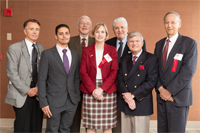
(l-r) Dr. Jim Boley, Dr. Mohamed Masoud, Dr. Lysle Johnston, Dr. Leslie Will, Dr. Eustáquio Araújo, Dean Jeffrey Hutter, and Dr. Roberto Justus
On Saturday, October 26, 2013, 106 people attended the Boston University Henry M. Goldman School of Dental Medicine’s (GSDM) Gianelly Symposium on Orthodontic Excellence. In addition to offering lectures on the future of orthodontics from distinguished figures in the field, the Symposium honors Dr. Gianelly’s professional achievements, as well as the leadership and mentoring he gave throughout his life.
Dr. Anthony A. Gianelly was an internationally recognized professor of orthodontics. Dr. Gianelly spent 42 years of his career at GSDM and was serving as Chair ad interim of the Department of Orthodontics & Dentofacial Orthopedics when he passed away in 2009.
After registering for the Symposium, attendees gathered in Keefer Auditorium to hear opening remarks from Dean Jeffrey W. Hutter and Anthony A. Gianelly Professor and Chair of Orthodontics & Dentofacial Orthopedics Dr. Leslie Will.
“It is thrilling for all of us to again host the Gianelly Symposium during Alumni Weekend 2013 and I trust that with the continued support of our orthodontic alumni, this will remain a tradition at our School,” said Dean Hutter. He continued, “Your presence and participation truly honors your mentor and I know he would be proud to see you here today.”
Dr. Will introduced the first speaker, Dr. Lysle Johnston, professor emeritus at the University of Michigan and Saint Louis University. His presentation, “Early treatment without smoke and mirrors: Tony had it all figured out,” examined the assumption that Class II malocclusions can be corrected by the “growth modification” treatment, which is currently hailed as the best option. Dr. Johnston discussed Dr. Gianelly’s more effective alternate maxillary-”distalization”-lower-lingual approach as an alternative.
Dr. Mohamed Masoud, Director of the Advanced Specialty Education Program in Orthodontics and Dentofacial Orthopedics at Harvard University School of Dental Medicine and adjunct clinical associate professor at GSDM, delivered the next presentation, “Growth prediction: past, present, and future.” He reviewed the timing of treatment in orthodontics and traditional radiographic methods for predicting the timing of the growth spurt. Dr. Masoud explored new methods that utilize biological markers to predict the timing and intensity of the growth spurt and outlined his vision for the future of growth prediction in orthodontics.
After a break, Dr. Roberto Justus presented “The anterior open bite: conservative orthodontic treatment with stability.” He discussed how the high relapse incidence of anterior open-bite malocclusion is frequently due to an anterior tongue rest posture. Dr. Justus detailed research indicating that a maxillary fixed intraoral appliance with spurs is essential to modify tongue posture. His research with this appliance in a large sample of anterior open-bite patients demonstrated long-term stability post-retention. Dr. Justus is a professor and research director at Intercontinental University in Mexico City; professor of undergraduate orthodontics at Technological University of Mexico; and president of the World Federation of Orthodontists.
After Dr. Justus’s presentation, attendees mingled over lunch in the Hiebert Lounge. Dean Hutter delivered a presentation honoring Dr. Gianelly.
Dean Hutter said, “Dr. Gianelly served as a mentor and father figure to his students and positively influenced countless lives as a teacher, mentor, colleague, and friend during the years he spent at the Henry M. Goldman School of Dental Medicine.” He continued, “He was an integral and founding member of what became the legacy of our School.”
Following lunch, Dr. Eustáquio Araújo presented, “Teeth and ideas in motion: give me a lever and I will move the earth.” Dr. Araújo is the Sotiropoulos professor and clinic director at the Center for Advanced Dental Education, Orthodontics at Saint Louis University. He examined treatment options for dilacerated teeth and ankylosed canines. Dr. Araújo discussed both old and new techniques.
Dr. Jim Boley, clinical associate professor of orthodontics at Baylor University College of Dentistry presented, “The four classic goals of orthodontic treatment.” These goals are: esthetics, health, function, and stability. He reviewed these and what treatment objectives can optimize the possibility of achieving all four.
After a final break, Dr. Will delivered the final lecture of the day, “Airway, X-rays, and growth: the shape of the future.” She spoke about the newest technologies available used to assess growth. By examining all the options, Dr. Will explained how orthodontists can choose the most appropriate treatment at the best time for patient care.
Photos from the Symposium are available on Facebook and Flickr.